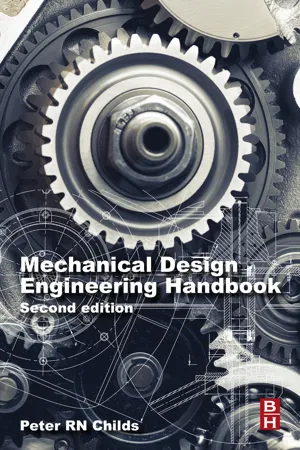Mathematics
Pulleys
Pulleys are simple machines that consist of a wheel with a groove and a rope or belt. They are used to lift heavy objects by applying force. In mathematics, pulleys are often used to illustrate concepts such as mechanical advantage and the distribution of force.
Written by Perlego with AI-assistance
3 Key excerpts on "Pulleys"
- eBook - ePub
- Peter Childs(Author)
- 2018(Publication Date)
- Butterworth-Heinemann(Publisher)
In a third-order lever, the force is between the fulcrum and the load. Mechanical advantage is reduced but the movement at the load point is increased.F e = F l L l /L e Serway and Jewett (2018)20.3 Pulleys
A pulley comprises one or more wheels running on shafts over which a rope has been looped in order to make lifting a load easier. A pulley is a class of device called a simple machine that enables force amplification in a manner similar to levers.In the case of a two-wheel pulley, Fig. 20.3 , the mass is supported by two strands of the rope. As you pull on the loose end of the rope, you only need to impart half the force of the load in order to lift it, but you will need to pull the loose end of the rope twice as far as the height through which the load is lifted. The term mechanical advantage is used to refer to how much a simple machine multiplies a force. For a two-wheel pulley, the mechanical advantage is two. Similarly with a four-wheel pulley, Fig. 20.4 , the mass is supported on four strands of rope, and you need to impart a force of one-quarter of the weight of the load in order to move it, although you will need to pull the loose end through a distance four times that of the height that the load is lifted. A four-wheel pulley provides a mechanical advantage of four.Fig. 20.3 Two-wheel pulley.Fig. 20.4 Four-wheel pulley.Although Pulleys provide mechanical advantage, the actual energy required to move the load is slightly more than the potential energy associated with the change in elevation because of friction between the rope and pulley wheels. A wide variety of pulley configurations are possible, with a selection of these presented in Table 20.2 .Table 20.2 A selection of some pulley configurationsType of Pulley Example Characteristics Useful equations and references Single wheel This configuration reverses the direction of the lifting force. As you pull down, the mass will rise. F applied = F load Serway and Jewett (2018) Two wheels With two wheels, the mass is supported by two strands of rope. This configuration gives a mechanical advantage of two, and it is possible to lift the load with half the force of the load. - eBook - ePub
- John Bird(Author)
- 2019(Publication Date)
- Routledge(Publisher)
Chapter 25 Simple machinesWhy it is important to understand: Simple machinesThis chapter commences by defining load, effort, mechanical advantage, velocity ratio and efficiency, where efficiency is then defined in terms of mechanical advantage and velocity ratio. These terms, together with other terms defined in earlier chapters, are applied to simple and quite complex pulley systems, screw-jacks, gear trains and levers. This chapter is fundamental to the study of the behaviour of machines and is thus important in studying the fundamental concepts of machine motion and behaviour.At the end of this chapter, you should be able to:- defineasimplemachine
- define force ratio, movement ratio, efficiency and limiting efficiency
- understand and perform calculations with pulley systems
- understand and perform calculations with a simple screw-jack
- understand and perform calculations with gear trains
- understand and perform calculations with levers
25.1 Machines
A machine is a device that can change the magnitude or line of action, or both magnitude and line of action of a force. A simple machine usually amplifies an input force, called the effort, to give a larger output force, called the load. Some typical examples of simple machines include pulley systems, screw-jacks, gear trains and levers. This chapter is fundamental to the study of the behaviour of machines.25.2 Force ratio, movement ratio and efficiency
The force ratio or mechanical advantage is defined as the ratio of load to effort, i.e.Science and Mathematics for Engineering. 978-0-367-20475-4, © John Bird. Published by Taylor & Francis. All rights reserved.Force ratio =(1)load effort= mechanical advantage - eBook - ePub
- W. Bolton(Author)
- 2015(Publication Date)
- Routledge(Publisher)
n is the number of pulley wheels.Figure 24.5 (a) Pulley, (b) pulley system, (c) Weston differential pulleyThe Weston differential pulley (Figure 24.5(c) ) has a fixed upper block which consists of two concentric wheels of different diameters with an endless rope wrapped round them. If a is the diameter of the larger wheel and b the diameter of the smaller wheel, then when the effort moves through a distance x , a length x of the rope is wound on to the larger wheel while a length bx/a is unwound from the smaller wheel. Thus the load is raised through a distance of ½(x - bx/a ) and so the velocity ratio is 2a /(a - b ).24.3.3 The wheel and axle
The wheel and axle (Figure 24.6(a) ) has the effort applied to a rope wound round a wheel and the load lifted by a rope wound round the axle. If the wheel has a diameter a and the axle a diameter b, then when the effort moves through a distance πa the load rises by πb. Hence the velocity ratio is a/b. If the axle can turn without friction, then the moment of the effort E must equal the moment of the load F and so Ea = Fb and the mechanical advantage is a/b.The differential wheel and axle (Figure 24.6(b) ) has an axle consisting of two portions of different diameters. The load is lifted by a pulley which is carried in the loop of a rope wound round the two portions of the axle. If a is the diameter of the wheel, b the diameter of the larger diameter axle and c the diameter of the smaller diameter axle, then when the effort moves through a distance πa we have a length of rope πb wound onto the axle and πc unwound. The load thus rises through a distance ½ (πb - πc ) and so the velocity ratio is 2a /(b 2 c ). If b is nearly equal to c
Index pages curate the most relevant extracts from our library of academic textbooks. They’ve been created using an in-house natural language model (NLM), each adding context and meaning to key research topics.
Explore more topic indexes
Explore more topic indexes
1 of 6
Explore more topic indexes
1 of 4


